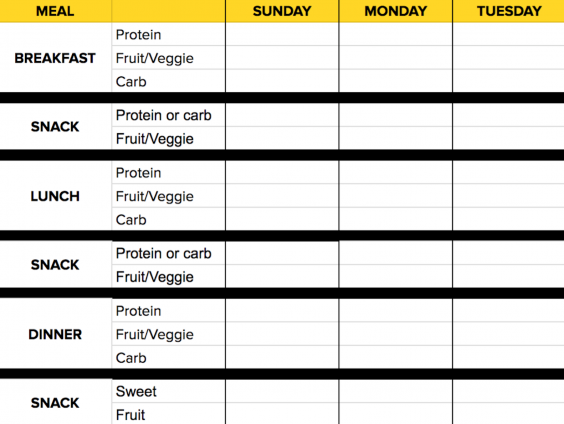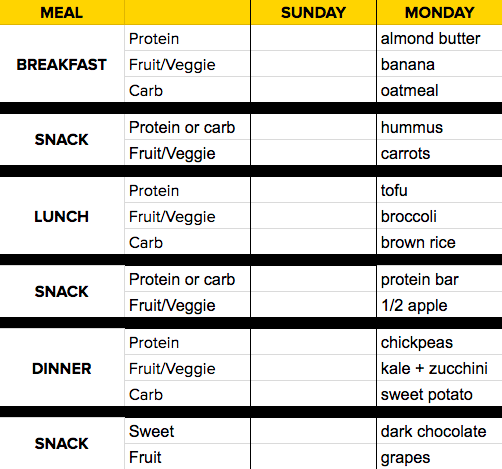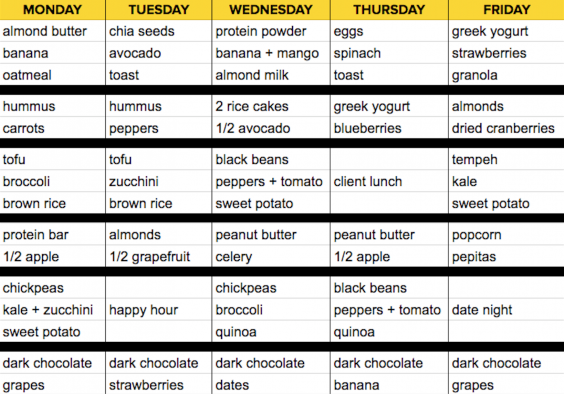I’ll never forget shelling out $120 for a 10-day meal plan and recipe collection during my junior year of college, only to find it wasn’t sustainable for me at all. Not because of the food, but because the meal prep part didn’t fit into my busy lifestyle.
Years later, I finally cracked the code: Sustainable meal planning all comes down to effective meal-prepping. That means not just getting in the kitchen for a cook-a-thon on Sunday, but also deciding which foods and meals actually work for your lifestyle.
To help you get started, I’m breaking down steps to create a customizable meal plan you can actually stick to. All you need: a goal and a spreadsheet.
Meal prep tips for all your food goals
1. Determine your goal
Committing to a meal plan works best when there’s something behind it to drive you. So, what’s your goal? Maybe you want to get rid of sugar cravings, make sure you’re getting enough greens, or try to develop balanced eating habits. You might even just be sick of spending so much time in the kitchen and looking for a better plan.
Once you’ve identified what’s prompting you to prep, try writing it down. You can even tack it on your fridge as a visual reminder of why you’re making this effort.
For me, the motivation came down to making all of my food decisions ahead of time. That way, I’m less likely to stunt my progress by making impulsive (and maybe expensive) eating decisions. Because let’s be honest… I’m not saying no to a box of donuts unless I have egg muffins left over from all the meal-prepping I did on Sunday.
2. Start with baby steps
Just like you wouldn’t completely overhaul your fitness routine to do an Iron Man, like, next week, don’t expect to become a Master Meal-Prepper overnight. Getting into a groove with meal planning takes time — so start small. Perhaps you ease into it by planning and prepping a couple of meals per week or just chopping some veggies on the weekend to get ahead. Little by little, you’ll determine the amount of prep work that makes sense for you.
3. Nerd out with a spreadsheet
You know what they say: Those who fail to prepare, prepare to fail. And it all starts with a super-simple spreadsheet. Whether you prefer Excel or Google Sheets, just pick one. (Or, if you’re old school, just use pen and paper.) Then nerd out like I do and color code it to keep yourself organized.
Here’s my empty meal plan grid. Consider this the first step in deciding what to meal-prep for the week.

My personal goal is to keep my meals balanced, so I split them all up into food categories: protein, produce, and carbs (a starch). I even split up my snacks like this, too. Thinking about my meals in food categories reminds me to make sure most meals I eat are pretty nutritionally balanced. This might be overly restrictive for some people, but for those who thrive on structure, it can be a helpful roadmap.
4. Be real with your social life
Planning healthy meals down to every last carrot stick may sound like a wellness fantasy — but it’s important to be realistic, too. Assuming you have a social life (or, really, any life outside your home), there are bound to be times you’ll need to deviate from 21 color-coded, spreadsheet-ed meals per week.
For most people, it’s best to build in some flexibility with weekly prep. This might look like leaving a few meals un-planned or including meals with shelf-stable ingredients that can be rolled over to the following week. This way, you’ll give yourself some wiggle room for that last-minute lunch with a friend or a happy-hour-turned-dinner.
5. Go “easy” when choosing your meals
This is the fun part. All you have to do now is fill in the meals you’re going to prep and cook at home. I like to use meal prep formulas instead of recipes. If you’re not a super experienced cook, it’s often easier to think of food in à la carte building blocks instead of stressing out about following a recipe to a T.
Here’s an example day:

Notice that instead of “tofu stir-fry” for lunch, I wrote tofu, broccoli, and brown rice. Jotting down the main ingredients versus the recipe name helps me stay focused on getting that balance at each meal. Plus, it leaves a lot of room for creativity. To make a meal actually taste good, I always use flavor additions such as garlic, soy sauce, agave, onions, lemons, limes, and spices. And I can use up whatever I have on hand.
Here’s what it will look like once I’ve filled in each meal:

You won’t see my weekends filled out, because if I’m too strict, then I set myself up for failure. (Remember what I said about wiggle room?) I’ve also gained some structure and know which foods will make me feel better overall. But guess what? If I go a little wild with pizza and beer one night, life goes on.
6. Start by shopping your pantry
Still trying to figure out what to actually make for all those upcoming breakfasts, lunches, and dinners? Before you get too deep down a Pinterest rabbit hole of recipes, step away from the laptop — and over to your pantry.
Taking stock of what you’ve already got on hand helps you not only save money by buying fewer ingredients, but reduces food waste, too. Could that half-box of spaghetti become an easy carbonara for Tuesday night’s dinner? Or a bag of spinach underlie a nutrient-rich salad for lunch? Before you know it, you’re halfway through planning your week!
7. Consider a meal rotation
Not gonna lie: Coming up with a dozen or more meals in one fell swoop can be a head-scratcher. Incorporating a meal rotation element takes the guesswork out of the eternal question of “What’s for dinner?”
You’ve heard of Meatless Mondays and Taco Tuesdays — two categories that work well as springboards for creative meal planning — but you can take the concept even further by giving each day of the week (or just each night’s dinner) its own theme. Want to round out your plan with Fish Fridays or get really wacky with, say, Swedish Saturdays? You do you. And hello, IKEA meatballs.
8. Make your grocery list
Now that you know what you’re eating, you can make your grocery list accordingly. This is my favorite part because it’s so easy: Write your list directly below your grid, so you just need to tally up how much you need of each ingredient. Take a screenshot before heading to the store so that all you have to do is pull up your photos.
9. Pick a day to meal prep
Now that you have your groceries, choose the best day to meal-prep your food for the week. My favorite days are Saturday and/or Sunday. Sometimes I spread it out by going to the store on Saturday, then meal-prepping all of my dishes on Sunday.
The key here is consistency. Meal planning and prepping are habits that may take some time to establish. The more you carve out time on the same days each week, the more they’ll become second nature.
10. Stock your kitchen with the right gadgets and containers
I’m a big fan of shortcuts. The right kitchen gadgets are a must for speeding up the meal prep process. From cutting boards that include storage for the chopped veg to mini-choppers that do the slicing and dicing for you, there are tons of tools that can streamline your cooking.
Meanwhile, give some thought to how your small appliances can work simultaneously to cut down on time. Oftentimes the slow cooker can be slow cooking while the oven bakes while the food processor processes. Get the picture?
Finally, you don’t want to finish with all that meal-prepping and have nowhere to stash your food. When you have matching containers (or at least enough containers that can store everything) it helps keep you organized and motivated. There’s no science behind that, but take my word for it.
11. Follow inspiring meal preppers on social
Sometimes, especially on a busy week, you may find yourself running out of meal prep steam. (I get it; it can be a lot of work!) To keep the energy alive — and get inspired by new ideas — consider following meal prep accounts on social media, or even getting into online groups. You’re sure to find resources you never even knew existed, plus plenty of camaraderie.
12. Try it with a friend (or involve the family)
A pair of extra hands in the kitchen helps move a recipe along more quickly, sure — but it also offers an opportunity to connect with friends and family. In fact, research specifically shows that cooking together promotes parent-child bonding. Plus, they’ll start to learn about food safety while they’re at it.
When everyone in the household has invested time in meal prep, they may even enjoy the food more. One study found that people liked food more when they had prepared it themselves. So grab an apron for your kid, spouse, partner, or friend and put ’em to work prepping!
Takeaway
Creating a meal prep and meal planning system you can stick to is a game-changer. Now my week feels out of whack when I don’t make a meal plan. Not only does it keep me focused on my health goals, it also prepares me to tackle whatever chaos is thrown at me each week.
Adopt a system that’s sustainable for you and tailored to your lifestyle, goals, and diet. If that includes some healthy desserts, too, then that sounds like a good plan to me.
Talia Koren is an influencer marketing specialist who genuinely wants to help people in their 20s get their lives together. She also loves cooking and runs the meal prep blog Workweek Lunch. Keep up with Talia on Instagram and Twitter @workweeklunch.


0 Commentaires